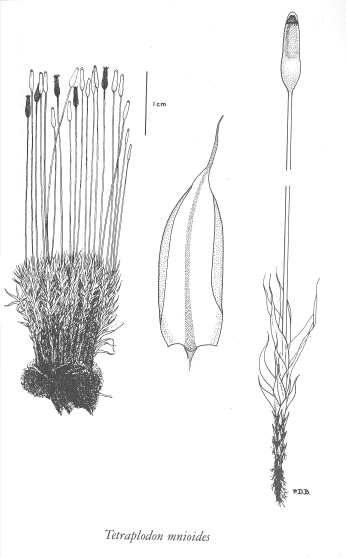Tetraplodon mnioides (Hedw.) B.S.G.
slender cruet-moss (entireleaf nitrogen moss)
Splachnaceae
Species Account Author: Wilf Schofield
Extracted from Some Common Mosses of BC
Introduction to the Bryophytes of BC
slender cruet-moss (entireleaf nitrogen moss)
Splachnaceae
Species Account Author: Wilf Schofield
Extracted from Some Common Mosses of BC
Introduction to the Bryophytes of BC
Species Information
Species description:
Genus name describing the peristome teeth that are often fused in fours when young. Species name meaning Mnium-like, although this similarity is difficult to discern.
Reproduction:
Sporophytes frequent, with brilliant red setae and dark brown to red-brown sporangia, maturing in summer. Sometimes dark brown to nearly black when dried.
Distinguishing characteristics:
The habitat on decomposing animal waste, the conic habit, the sporangia that show a somewhat swollen lower portion and a cylindric portion above it, and the usually wine-red seta are usually reliable features.
Habit:
Forming hard, rounded to conical, dark green to light green tufts.
Similar Species:
T. angustatus is very similar but the leaves are toothed (clearly visible with hand lens); those of T. mnioides lack teeth. T. pallidus is similar but has yellow setae and pale sporangia; Y. urceolatus is also similar but the seta is very short and the tufts are often very dense; the sporangia are also short and stout. Yayloria species usually do not form tufts and the sporangia lack a swollen lower portion. Splachnum sphaericum and S. vasculosum usually have very long, slender and readily collapsing setae; those of Tetraplodon are rigid.
Illustration

If more than one illustration is available for a species (e.g., separate illustrations were provided for two subspecies) then links to the separate images will be provided below. Note that individual subspecies or varietal illustrations are not always available.
Illustration Source: Some Common Mosses of BC
Habitat and Range
Habitat
Animal-waste in bogs, open-forest, and trail margins, from sea level to sub alpine elevations. Range
World DistributionCircumpolar in the Northern Hemisphere, also in southern South America and New Guinea; in North America extending southward in the east to New York and the Great Lakes area, and in the west to southern Oregon.
Status Information
Synonyms
Synonyms and Alternate Names:
Tetraplodon mnioides var. brewerianus (Hedw.) Bruch & Schimp.
Tetraplodon mnioides var. paradoxus (R. Br.) C.E.O. Jensen